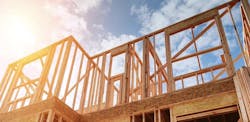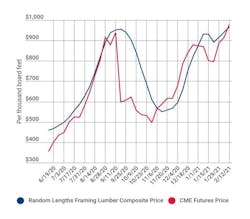Lumber Prices Hit Record High, Threatening Housing's Momentum
The price of softwood lumber reached a record high today of $966 per thousand board feet, according to the Random Lengths Framing Lumber Composite reflecting the highest volume-producing regions of the U.S. and Canada. The price tops the most recent peak of $955 set in September 2020 and continues a general pattern of escalation since initial COVID-19 stay-at-home restrictions were put into effect nearly a year ago.
Effects of Rising Lumber Prices
For home builders, framers, and remodeling contractors, the impact has eroded profitability, stalled production, and led to cancelled sales contracts and all-out shut-downs of projects—all of which works against housing affordability.
"We are shocked and very disappointed to see the prices had gotten to that level," said Jerry Howard, CEO of The National Association of Home Builders (NAHB) in an exclusive interview with Pro Builder earlier today. "We've been talking to our friends in the timber industry for months about how increasing (lumber) prices is putting the nation's economy into grave jeopardy."
Simply, says Howard, builders can't afford the lumber to build houses, threatening what he called "the buoy for the whole American economy" that the residential construction sector provides as the nation slowly emerges from a global health crisis. "I don't know what they (lumber producers) are thinking, but it is a very dangerous path they're going down."
In fact, despite overtures by NAHB and former Commerce Secretary Wilbur Ross, lumber producers have to date refused to meet with housing industry officials about the ongoing lumber price escalation. "The message we've been sending them through the media and third parties is that they are grossly underestimating housing demand for this year and next year," said Howard. Single-family building permits rose 11% in 2020 and are forecast to increase another 5% in 2021 and 3% in 2022 to reach 1.068 million units a year, the most since 2007.
"[Lumber producers] are grossly underestimating housing demand for this year and next year."
Howard also added that, in his view, lumber producers are "behind the curve" in making their workplaces safe against the spread of the coronavirus. "After all, if we [home builders] can make construction sites COVID-safe, certainly timber mills can [and] we feel they have an obligation to do so as quickly as possible to keep at least one component of the American economy moving forward."
Timber Sourcing Issues?
Part of the issue is that lumber producers are having their own problems sourcing raw timber to mill into studs, posts, and joists. "There is, I think, some concern on their part that the ability to harvest on our national forests may be curtailed by a Biden administration in terms of environmental and safety regulations, but that hasn't happened yet," said Howard. "The way to protect against that is not to shut down and cause huge disruptions in the economy."
Howard said a slight, if short-lived, dip in lumber prices, from late September to early December 2020, was the result of a legal judgement and pressure applied by the Trump Administration that enabled the U.S. Commerce Department to reduce duties (tariffs) on shipments of Canadian lumber into the U.S from 20% to 9%, helping boost supply and reduce costs ... for a time.
Early communications with the Biden Administration, however, have been less fruitful. "We have been told that, for the first year, President Biden is going to focus on domestic issues, so it's unlikely that the Canadian lumber tariff will be on the front burner anytime soon."
RELATED
- NAHB Leadership Predicts Lumber Price, New Administration Effects on Housing
- Softwood Lumber Prices Fall Dramatically in November
- Shortages and Booming Builder Activity Push up OSB Prices
- What’s Behind the Softwood Lumber Price Spike?
Real-World Impact of Higher Lumber Prices
Reports from jobsites nationwide reflect the direness of the situation. Alicia Huey, a high-end custom home builder from Birmingham, Ala., and second vice chairman of NAHB, said that the price of her lumber framing package on an identically sized home has more than doubled over the past year from $35,000 to $71,000. “This increase has definitely hurt my business,” she said. “I’ve had to absorb much of this added cost and even put some construction on hold because I would be losing money by moving forward.”
In addition, Howard says, appraisals of new homes for mortgage loan qualification "are right at building costs. They don't take into account overhead or profit for the builder, which is a bad way to go." Education and awareness among appraisers about lumber prices, he said, as well as a hard look at the appraisal process, would help get that side of the industry better aligned with the current situation.
Advice for Home Builders
If lumber prices remain high for much longer, said Howard, builders will need to look at alternative framing materials, such as steel, or advanced technologies, such as 3D printing, to get homes built.
In the meantime, Howard advises builders to try to get clauses into their sales contracts that allow for changes in the costs of their building materials, particularly lumber, and, if they can, stockpile lumber, either on their own or with other builders and contractors, to hedge against future price increases.



